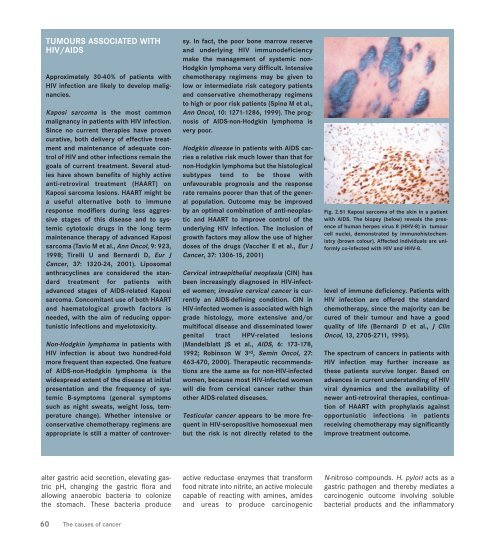world cancer report - iarc
world cancer report - iarc
world cancer report - iarc
You also want an ePaper? Increase the reach of your titles
YUMPU automatically turns print PDFs into web optimized ePapers that Google loves.
TUMOURS ASSOCIATED WITH<br />
HIV/AIDS<br />
Approximately 30-40% of patients with<br />
HIV infection are likely to develop malignancies.<br />
Kaposi sarcoma is the most common<br />
malignancy in patients with HIV infection.<br />
Since no current therapies have proven<br />
curative, both delivery of effective treatment<br />
and maintenance of adequate control<br />
of HIV and other infections remain the<br />
goals of current treatment. Several studies<br />
have shown benefits of highly active<br />
anti-retroviral treatment (HAART) on<br />
Kaposi sarcoma lesions. HAART might be<br />
a useful alternative both to immune<br />
response modifiers during less aggressive<br />
stages of this disease and to systemic<br />
cytotoxic drugs in the long term<br />
maintenance therapy of advanced Kaposi<br />
sarcoma (Tavio M et al., Ann Oncol, 9: 923,<br />
1998; Tirelli U and Bernardi D, Eur J<br />
Cancer, 37: 1320-24, 2001). Liposomal<br />
anthracyclines are considered the standard<br />
treatment for patients with<br />
advanced stages of AIDS-related Kaposi<br />
sarcoma. Concomitant use of both HAART<br />
and haematological growth factors is<br />
needed, with the aim of reducing opportunistic<br />
infections and myelotoxicity.<br />
Non-Hodgkin lymphoma in patients with<br />
HIV infection is about two hundred-fold<br />
more frequent than expected. One feature<br />
of AIDS-non-Hodgkin lymphoma is the<br />
widespread extent of the disease at initial<br />
presentation and the frequency of systemic<br />
B-symptoms (general symptoms<br />
such as night sweats, weight loss, temperature<br />
change). Whether intensive or<br />
conservative chemotherapy regimens are<br />
appropriate is still a matter of controver-<br />
alter gastric acid secretion, elevating gastric<br />
pH, changing the gastric flora and<br />
allowing anaerobic bacteria to colonize<br />
the stomach. These bacteria produce<br />
60 The causes of <strong>cancer</strong><br />
sy. In fact, the poor bone marrow reserve<br />
and underlying HIV immunodeficiency<br />
make the management of systemic non-<br />
Hodgkin lymphoma very difficult. Intensive<br />
chemotherapy regimens may be given to<br />
low or intermediate risk category patients<br />
and conservative chemotherapy regimens<br />
to high or poor risk patients (Spina M et al.,<br />
Ann Oncol, 10: 1271-1286, 1999). The prognosis<br />
of AIDS-non-Hodgkin lymphoma is<br />
very poor.<br />
Hodgkin disease in patients with AIDS carries<br />
a relative risk much lower than that for<br />
non-Hodgkin lymphoma but the histological<br />
subtypes tend to be those with<br />
unfavourable prognosis and the response<br />
rate remains poorer than that of the general<br />
population. Outcome may be improved<br />
by an optimal combination of anti-neoplastic<br />
and HAART to improve control of the<br />
underlying HIV infection. The inclusion of<br />
growth factors may allow the use of higher<br />
doses of the drugs (Vaccher E et al., Eur J<br />
Cancer, 37: 1306-15, 2001)<br />
Cervical intraepithelial neoplasia (CIN) has<br />
been increasingly diagnosed in HIV-infected<br />
women; invasive cervical <strong>cancer</strong> is currently<br />
an AIDS-defining condition. CIN in<br />
HIV-infected women is associated with high<br />
grade histology, more extensive and/or<br />
multifocal disease and disseminated lower<br />
genital tract HPV-related lesions<br />
(Mandelblatt JS et al., AIDS, 6: 173-178,<br />
1992; Robinson W 3 rd, Semin Oncol, 27:<br />
463-470, 2000). Therapeutic recommendations<br />
are the same as for non-HIV-infected<br />
women, because most HIV-infected women<br />
will die from cervical <strong>cancer</strong> rather than<br />
other AIDS-related diseases.<br />
Testicular <strong>cancer</strong> appears to be more frequent<br />
in HIV-seropositive homosexual men<br />
but the risk is not directly related to the<br />
active reductase enzymes that transform<br />
food nitrate into nitrite, an active molecule<br />
capable of reacting with amines, amides<br />
and ureas to produce carcinogenic<br />
Fig. 2.51 Kaposi sarcoma of the skin in a patient<br />
with AIDS. The biopsy (below) reveals the presence<br />
of human herpes virus 8 (HHV-8) in tumour<br />
cell nuclei, demonstrated by immunohistochemistry<br />
(brown colour). Affected individuals are uniformly<br />
co-infected with HIV and HHV-8.<br />
level of immune deficiency. Patients with<br />
HIV infection are offered the standard<br />
chemotherapy, since the majority can be<br />
cured of their tumour and have a good<br />
quality of life (Bernardi D et al., J Clin<br />
Oncol, 13, 2705-2711, 1995).<br />
The spectrum of <strong>cancer</strong>s in patients with<br />
HIV infection may further increase as<br />
these patients survive longer. Based on<br />
advances in current understanding of HIV<br />
viral dynamics and the availability of<br />
newer anti-retroviral therapies, continuation<br />
of HAART with prophylaxis against<br />
opportunistic infections in patients<br />
receiving chemotherapy may significantly<br />
improve treatment outcome.<br />
N-nitroso compounds. H. pylori acts as a<br />
gastric pathogen and thereby mediates a<br />
carcinogenic outcome involving soluble<br />
bacterial products and the inflammatory

















